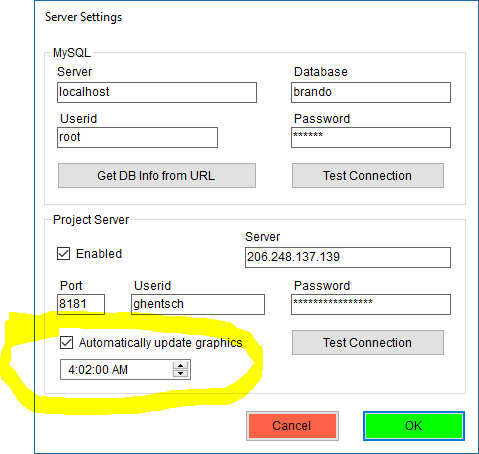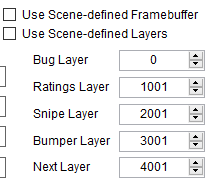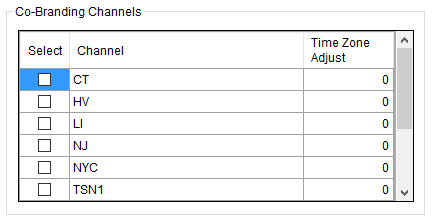The ":" character is forbidden in Brando scene names
Brando uses the colon character to distinguish the name of scenes in shared projects from scenes in the channel project. In Flow, when you see a resource with a name like nextboards:next4way, the name tell us the resource (scene) came from shared project nextboards. For this reason, do not include a colon in any of your resource names (scenes).
Shared Projects vs. Channel Project
Scenes (aka resources) can either be unique to a channel or shared among channels. When shared, they're best put into their own XPression xpf and shared among multiple channels. Shared projects are stored by default at d:\brando\shared\. When running Gears, shared projects are made available to a channel by selecting the shared projects from a list. Each channel requires a channel project however even if it's got no brando scenes in it. Brando uses it to create dynamic scenes/materials for Sponsored Snipes.
Named Snipes
Named snipes is a way of defining snipes for one, some or all channels. The scenes in the project are used as templates for defining the actual named snipe. These can be for sponsor ads, programming promos or anything really. The name in named snipes is really just the house id or naming convention used by a broadcaster. They are often triggered as secondary events from automation using the house id string as part of the command. However, named snipes can be used manually from Switcher which is especially useful for live programming.
When a Named Snipe scene is defined in Flow, the user defines the channels it is available for. This might be used to define a sponsor for a group of channels only.
Other useful information is start, expiry and tag time. Start is when the named snipe is available for playout, Expiry is when a named snipe no longer can be used and tag time is the standard time shift and is only available if implicit tags are available in a scene.
How to Make New Graphics Available for a Channel
Workflow with Project Server
- make sure you're using the most recent revision of graphics from project server.
- make changes
- publish changes to Project Server
- run gears to make resources available for scheduling and to notify Player that new graphics are available for deployment. Make sure all shared projects are included or they won't be available for scheduling in Flow.
Workflow without Project Server
- make changes
- run gears to make resources available for scheduling. Make sure all shared projects are included or they won't be available for scheduling in Flow
Note: When updating graphics for a channel using gears, it marks the channel as having new graphics available. This is done by setting a flag in the database for the channel to indicate that new graphics are available. The player has a timer that checks this flag and when it's set, it'll display both in Player and Switcher with the message "New version of graphics is available".
So, how to update the graphics when you see this in the player:
There are 3 choices:
Auto Update on a Timer
This option is only available when Project Server is enabled. When launching the Player, you'll see a preference which looks like:
If this is set, when the time is reached daily, the graphics will be updated automatically if new graphics are available..
Project Server
- take the player offline by clicking on the On Air logo or by using the menu item Actions→On Air or using keyboard shortcut F5
- Deploy new graphics by using menu item File→Deploy New Graphics
- Bring the player back On Air using the reverse of #1
Without Project Server
You have a choice here. You can either relaunch the player or
- take the player offline by clicking on the On Air logo or by using the menu item Actions→On Air or using keyboard shortcut F5
- Deploy new graphics by using menu item File→Deploy New Graphics
- Bring the player back On Air using the reverse of #1
Creating Scenes
See Resource Scene Naming Convention to get the details.
Scene Tag Names
See Program (Implicit) Tags to get the details.
Using Dynamic Fields and Logos
There are 2 types of dynamic fields and logos available currently for programs and scheduled resources - text and logo.
For scheduled resources, any tag name that is prefixed with a ^ is a dynamic tag. If it's a textbox, it's a dynamic field and if it's a quad, it's a logo. When a resource is scheduled in flow, a list of dynamic tags is made available for assignment.
When it's a dynamic logo, only the logos in subdirectories of the dynamic logo are available for assignment.
What Range of the Scene Gets Played?
The scene plays from the start position of where the play head was left in the scene editor and plays until the end of the last clip on any track in the scene directory. All tracks get played this way. When the scene is done playing, Brando Player does a fade off for all scenes except Bugs or Switcher whether it needs to or not. It's best to have the scene clear itself but if not, the scene fades off as a 10 frame fade-off.
Brando Player plays back it's scenes using the XPression api call xpSscene.SceneDirector.Play().
XPression Layers and Other Constants
These are the default constants Brando Player uses.
What this means is the z order of scenes from top to bottom is:
- Next
- Bumper
- Snipe
- Rating
- Bug
These defaults can be modified as desired. There's also an option to use the layers and frame buffer ids defined in the scenes which overrides the above settings.
How to Add a Delimiter for Switcher Crawls?
The attached scene to a swicher crawl supports a single caption called Caption1. If that scene only has that textbox, all crawls will be butt up against each other. To remedy that, put a quad or textbox before Caption1 and you get an instant delimiter. Going forward, what we may do is support a delimiter scene with prefix "Delimiter" which always gets rendered after Caption1. That way the delimiter isn't forced at the beginning of the crawl.
Co-Branding Channels
Brando supports programming information for the selected channel by default but all or some other channel scheduling can also be used for resource output. The co-branding channels are selected in prefs on launch of Player:
All channels selected in the list will have it's program channel available by the player. This means any of the implicit tags (^now and ^next tags) can use scheduling information from these additional channels.
A tag like ^now.name will give you the name of the current channel's program. To use programming from another channel, use the suffix "[channel name]". So, to have channel WABC's current program displayed in a scene, use the tag ^now.name[WABC].
Named Snipes
Named snipes are global to all channels. They are defined in Flow using a name (aka house id) which allows for triggering from automation or the switcher. The XPression graphics for named snipes are stored by default in d:\brando\named snipes\named snipes.xpf. Adding the named snipes scenes from the xpf is done using Gears. Once Gears adds the scenes to the database, the Named Snipes can be defined in Flow. Named Snipes support everything that a standard snipe supports including dynamic tags and programming information. A single named snipes scene can be used for unlimited Named Snipes in Flow. For example, a scene with a quad named ^sponsor can have different named snipes defined with each using different media for the quad. That way, each named snipe can correspond to a house number in traffic.



